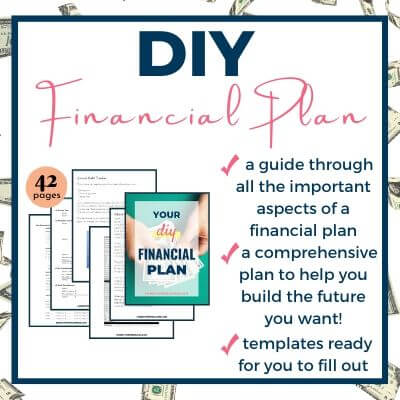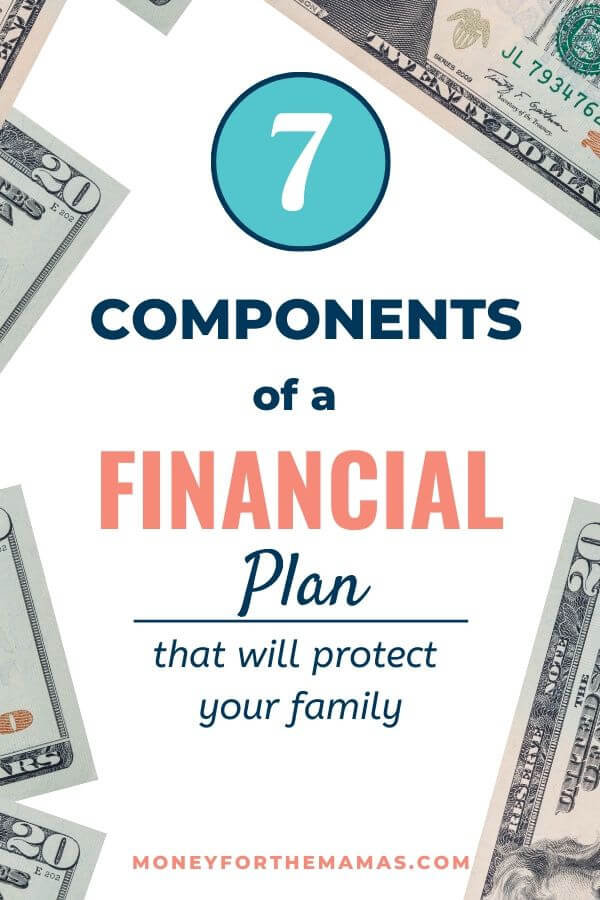How to Make A Family Financial Plan (just like an expert)!
We’ll walk through the steps to DIY your financial plan

Author: Kari Lorz – Certified Financial Education Instructor
Adulting. Sometimes it stinks! Going to the DMV, paying taxes, eating kale! Ugh! (actually, I like kale). But you get the idea, right? One of the things that we tend to put on the backburner is having a financial plan. It’s boring (kind of like flossing), yet we know we need to do it! So let’s get this one off of your to-do list!
Now, I am not a licensed financial planner; I’m just a nerdy mom, who geeks out on retirement planning, investment calculators, and happens to be rather good at it. I have gone through this process with professionals for my own purposes, and this post walks you through it all!
The plan I will outline for you is an excellent starting place to get you thinking about what is important now and what will be important later. At some point in your life, depending on the complexity of your assets, you should see a licensed financial planner to make doubly sure you are headed in the right direction and at the right pace.

This post may contain affiliate links. If you make a purchase, I may make a commission at no cost to you. Please read my full disclosure for more info
What is a financial plan?
A financial plan is just a framework and a plan for how you want your financial life to go and how you will fund that life. It’s something that you need to decide upon very soon as investment growth is critical.
We’re talking about a family financial plan because if you’re on this blog, you’re most likely a mom with kids.
The difference between a regular financial plan and a family financial plan is that you will probably need to consider more life insurance and a more detailed will. Families just need things spelled out a lot more than a plan for an individual.
I will walk through the main components of a family financial plan, and depending on your situation’s complexity level, you may want to see a financial planner and a good lawyer (we did both).
Steps in financial planning
There is a process to follow, as some things have to come before other things. So here’s a rough guide of the steps in financial planning…
- Gather your information – get all your account information together. Bank statements, investment documents, asset list, debt figures, and loan paperwork.
- Make a rough plan – how do you want to spend the rest of your days? For example, traveling, or at home, part-time work, etc.
- Use an online retirement calculator – you need to see if you’ll have enough to retire like you want to.
- Evaluate accounts & contributions – If the retirement calculator says you need to save more, make a plan for how you will do that. Need different accounts (401k, IRA, high-yield savings accounts, etc. Do you need to increase your contributions to have enough? Go through your monthly budget; where can you find the money?
- Seek a CFP – if you want to, you should seek the help of a certified financial planner to help you with your investments. Or, you can do a Robo-advisor or manage your portfolio yourself. Totally up to you and your comfort level with investing and if you can afford to have a financial professional.
- Get insurance – make a plan to cover your spouse, dependents, and property.
- Estate planning – this is where you’ll look at what will happen to your things after you pass away. This is the step where you should seek professional help if your situation is complex.
The financial planning process slightly overlaps the components of your plan below, but there we go into a bit more detail of the what & how.
Components of a financial plan
Almost all financial plans contain the same components, yet depending on your lifestyle, some may not be necessary. For example, if you don’t have kids/dependents, then you don’t need life insurance. No debt? Then no need for a repayment plan (yes, still map out your mortgage scenario).
1. Your net worth
Before you start dreaming about your future, you need to know your starting point. The best way to do this is to figure out your net worth. But, first, you’ll need to collect some figures; your assets and your liabilities.
Assets:
- home market value
- investments value
- bank account balances
- car value
- jewelry value
- misc assets
Liabilities:
- mortgage balance
- personal loans
- credit card debt
- student loan debt
- car loan balance
- medical debt
You total each column and take the asset total – liability total = net worth. For a while, you may have a negative net worth (especially if you just bought a house). It’s okay; we all start with nothing. This is just a snapshot of your current financial situation.
2. An excellent working monthly budget
Everyone needs some sort of working family budget. The level of detail is where we will all differ. I wrote a five-part series, Your Ultimate Guide on How to Budget, so if you need a budget, be sure that you pin those posts to check out later!
The number one thing that you need to make sure about is that your monthly expenses are less than your income, thus having a positive cash flow. This is a must! Ideally, you’d also be calculating your ideal savings rate into that household budget (more on that below).
3. A debt repayment plan
One of the easiest yet worst things that you can do is not to have a strategy to repay your debt. You need to be strategic on how to pay your debt and not a penny more (paying interest sucks). I did a detailed post that goes through the top two debt repayment strategies. Check it out and see which is best for your situation!
You can also seek the help of a local non-profit that helps with financial counseling and debt repayment plans. Don’t go to a business; they are a waste of your money. You just need help with the education piece, which is where the nonprofits are focused.

4. A savings plan
Yes, you want to be rich; almost everyone does! Welcome to the club. But what that looks like is different for everyone! What does being “rich” look like to you, and how soon? Being rich could mean a very modest home with spending money for travel. Or maybe rich means lots of free time for hobbies, or perhaps you want a huge house?
To get to any of these outcomes, you need to save some money! So you need to figure out your financial goal for your total retirement account. This should be a mix of short term goals to be used as stepping stones to reach your long term financial goals.
This is where people throw out the very simplistic savings goal of the Rule of 25. This is at the start of your retirement period; you should have 25X your income to “have enough” to live on during retirement. This is a good general place to start with. BUT, you need to absolutely adjust it from there depending on your unique situation.
There are a few different vehicles for your savings…
- High yield online savings account like Ally Bank. This is a great place to keep your emergency fund (6-9 months of expenses), as they have a much higher interest rate than a regular bank. Think .50% earned vs. .03% at a brick & mortar bank.
- Checking & savings accounts – this is good for your everyday usage. Just be sure that you know how/why you will be charged fees, as they can add up fast and for odd reasons. Look for the fee table for your accounts. Usually, you can keep your account’s fee-free by
- Having an automatic deposit
- Having a mortgage through your bank
- Maintaining a certain minimum daily balance
- Having an automatic deposit
- Saving for your retirement – Yes, you need to save for retirement, unless you want to work forever? I didn’t think so. So let’s talk about savings rates. At a minimum, you should save at least the minimum match amount that your employer contributes, usually anywhere from 2-15% (normal is around 5-7%). So there’s your minimum.
You should try and save more though (of course, no one says to save less, right). Your total savings rate depends on how much money you want to have at retirement, how soon you want to retire, and what you can actually afford out of your paycheck now. You’ll find a ton of different retirement calculators online. Use the one that makes the most sense to you; a great starting point is this calculator.
If you’re a little worried about not having enough to go around, an excellent place to start is 5%; ideally, you’d work up to at least 15% over a few years.
- A workplace 401(k) – almost all offer a traditional plan (contributions are made pretax), and hopefully, your workplace offers a Roth option too (funded with after-tax contributions). Using a Roth is my personal preference; I’ll do a piece on it soon as to why. For now, just know that there are plenty of people who like both options.
- An IRA is similar to a workplace 401(k), yet you control the investments, which is ideal, as workplace 401k options are limited and may not offer low fee options. These are great as SAHM can get a spousal IRA to have their own retirement savings.
- Social Security benefits- as a taxpaying citizen, you are entitled to a portion of what you paid to be returned to you once you reach the age of 61 1/2. Yet, it may be in your best interest to wait until you get to 65. Just how much you’ll receive is up for negotiation. Many believe that SS will run dry soon, do I? I’m not nerdy enough to have an educated opinion on that. But I do know that you can go to My Social Security, sign up for an account, and they’ll tell you how much you’ll be entitled to based on your reported earnings.
- College 529 Plan- if you have children, you may want to consider a college savings plan for your children’s future. Unfortunately, college is crazy expensive, and financial aid will only get your child so far. Each state has its own plan, but you’re not limited to getting the plan from your state. Here’s a great site to help you navigate 529’s and which plan might be best for your child.
These are the big accounts & reasons for saving money, but don’t forget that you may want to save for smaller things like holidays, vacations, birthday parties, etc. For these, you can set up sinking funds, either by using cash envelopes or regular checking accounts.
There is a growing mania around the FIRE movement, where people are saving 50% or more of their income to become Financially Independent and Retire Early.
An investment strategy
Now that you are saving money, you need to put it somewhere safe, somewhere that it can grow. Yes, it absolutely needs to grow, as you can’t let it sit in a regular bank account, as it will never keep up with inflation, you’ll be losing money. Compound interest is one of the most important financial concepts to understand & master! To take advantage of this, you need to invest your money in some way.
If you are taking place in your workplace 401k, your money is already invested (cool!) If your money is in an IRA, you need to make sure that you have actually invested it, and it’s not in a holding account, so to speak. (that’s bad).
You can invest in stocks, bonds, real estate, mutual funds, index funds, and more! (but no, you are not allowed to invest in bitcoin, that’s foolish).
Your investing strategy is something that you need to make sure you are 100% comfortable with, and you need to stick with it! You can’t flip flop back and forth like choosing tacos or nachos. You need to pick a strategy and stick with it for the long haul! Yes, of course, you can always change your mind, but doing it too often is what kills growth and puts you back at square one.
When I say pick an investment strategy that you are comfortable with, I am talking about your risk tolerance. Do you want to invest your money at higher risk but with the potential for a greater return? Or would you rather go for lower returns but more stability? If seeing the market take a dramatic drop, and you want to sell it all, that’s bad because that’s the wrong thing to do. You need to be able to weather the rocky years (because they will happen).
I am not your financial advisor, yet one of the most common sense books about investing is JL Collins, The Simple Path to Wealth. To me, it just makes sense. I am not looking for flashy investments or quick gains with lots of actions. I am a believer in the slow & steady; that’s me. I want to put my money in and not touch it for a few decades, just ride the market fluctuations out, and choose when I want to withdraw my money (and not be forced to sell in bad markets due to necessity).
- Collins, J L (Author)
You need to decide this without influence from others. You don’t want to give yourself ulcers or have panic attacks, yet you want your money to grow. So choosing the right combination of investments for a balanced portfolio is something that deserves your full attention.
Covering your bum with life insurance
Isn’t bum just fun to say? ? What I mean by covering your bum is having adequate insurance…
- health insurance
- car insurance
- home/renters insurance
- life insurance (if you have dependents)
- disability insurance
- umbrella policy
I’d rather not shell out loads of cash every month for something I don’t use and don’t want to use, but I know I need to make sure we are covered. Going through insurance coverage is a whole beast, so we won’t go into the tiny details here and now. Just know that you need to have most of the above-bulleted list. Yet, if you have a yearning to learn more about the different types of insurance, then jump on it now!
I do know that you never want to get life insurance through your workplace; you always want it to be independent of your job. Why? Well, when you get life insurance, you get a better rate the younger you are (as you are less likely to be ill).
Let’s say you have a job for ten years, and then you leave that job. You have just lost your life insurance policy, and now that you are ten years older, it will cost you a lot more to be covered. Or worse yet, you lost your job (thus your life insurance policy), and something horrific happens to you before you get a new job. Your family now doesn’t get anything. If you are the primary income provider, this is going to have a dramatic impact on your family at an especially hard time.
Another common mistake is not insuring the stay at home parent, especially if you have young ones at home. As a SAHM, you are typically the…
- Housecleaner
- Errand doer
- Daycare provider
- Meal cooker
- Misc planner
If you weren’t there to do these things, then most likely, your spouse would have to hire help to do most if not all of the above. Daycare costs alone could strip your monthly budget down to nothing! So be sure that you are covering all your bases by insuring the stay at home parent!
Another safety net that I always recommend to people is that they freeze their credit for themselves and their children (sometimes elderly parents too). There’s no reason to leave yourself open to scammers and data breaches! It takes 20 minutes max, so get on this today!

Your estate plan
Along with having adequate insurance, you need to get your estate ready. These are probably the hardest documents to complete as we never want to think about passing away and leaving our family, especially if we have young children. Yet, if you have a family, you absolutely want to get this taken care of!
You will need legal & notarized documents that include…
- A will – what you want to happen with your assets
- An advanced directive – what you want to happen in a medical sense if you are incapacitated
- A power of attorney – who you want to manage your finances if you are unable to make decisions
- Guardianship of minors – this is who you want to raise your kids if you should pass away before they turn 18. If you have a complicated family life, you absolutely want to make sure that your child goes to the person you trust the most!
Even with these documents, you may want to go a step further and put your assets into a Trust, specifically a Revocable Living Trust. This is a vehicle that transfers your assets to your designated trustees in the most tax-efficient and timely manner. Depending on the complexity of your assets, you could do them online at LegalZoom or go to a lawyer. Again, depending on the complexity, this could be $300 for online documents or up to a few thousand dollars for a lawyer.
While not necessarily part of a financial plan, you should also consider protecting your personal information. Identity theft can wreak havoc on your financial life. Imagine being on the hook for tens of thousands of dollars of someone else’s spending! Instead of being the victim of identity theft, protect your information by freezing your credit. That way, no one can take out a line of credit in your name. It’s a smart safeguard available to everyone.
Your financial plan working to make your dream retirement
I hate to say it, but there are a few more things you’ll need to consider when making your financial plan
- Housing in retirement – will your house be paid off by then? See if you can make that happen if at all possible, as that’s a significant expense to have monthly without any income coming in.
- Healthcare costs – this is proving to be the most expensive part of retirement for many. According to PlanSponsor, “A 65-year old couple retiring in 2019 can expect to spend $285,000 in health care and medical expenses throughout retirement”. (insert awkward silence and a teensy tiny bit of shock).
- Taxes – The stereotypical scenario of older Americans moving to Florida is actually for a good reason. Besides the weather, readily available healthcare, the taxes make it less expensive to live there. In fact, WalletHub rated Florida the #1 state for retirees.
- Part-time employment – Many retirees take a few years off for fun and then find themselves a bit bored, or they get a job and work just enough to get healthcare benefits. It could be a good option for you if you like to stay busy and need a bit of income.
- Life expectancy – oh fun! Yup, your investments need to cover you through your entire life, but that period could vary wildly. You don’t want to scrimp and save only to die at 67. Yet you don’t want to be 98 and living in poverty. So there we are. In 2018, the average life expectancy was 78.7 years. This is where you would use the 4% rule. This is a generally accepted rule of thumb that says you can withdraw 4% of your portfolio value each year in retirement without incurring a substantial risk of running out of money.
Why you need a family financial plan
One of the biggest financial mistakes people can make is not doing anything with your money, and just letting it sit. Sometimes people are too scared to do anything with their money, afraid of making a wrong turn. Please don’t do this, you need to get your money working for you!
If you are someone who wants to eventually retire and spend time doing hobbies, traveling, relaxing, or give back to your community through volunteering, then you need a financial plan; especially a financial plan for women’s needs.
On the other hand, if you always want to have to work because you haven’t saved anything, then you don’t need a financial plan.
Those are the two options open to everyone. It’s totally your choice. I’m going to assume that you do want to retire, and that’s why you’re reading this. Now let’s dig into how you can build your financial plan!
- Sign up with ibotta and get $10 sign up cash as a new customer!
- Earn points on ANY receipt from ANY store and redeem for gift cards with the fetch rewards app.
- Sign up with Inbox Dollars and get paid to read emails, watch videos, and take surveys. Easy peasy!
- Get free gift cards & cash for the everyday things you do online at Swagbucks. Use the link and get a $5 bonus
- Save money on gas by signing up with Upside; it gives you up to $.25 cents cash back per gallon! Use the code AFF25 when you sign up; you’ll get a $.25 cents per gallon bonus!
- Sign up with Cash App and get a $5 bonus when you use code “NRTZMHV.” You have to complete the sign up requirements to get the bonus! Read how to do this here with point #1.
At the end of the day
When you create a plan around something, you gain control over it. I know creating a family financial plan sounds a bit daunting & overwhelming, but you will feel so much better after you do this. After you do this, you will know what you want your financial future to look like (don’t worry, you can change your mind) and what you need to do to get there! Creating a DIY financial plan makes your dreams become your reality!

Articles Related to DIY Financial Plan:
- Emergency Fund FAQ – Everything You Need to Know
- Your Ultimate Guide on How to Budget
- Compound Interest – Your new BFF!
- Why You Should Absolutely Freeze Your Credit!








We really need to get a will/advanced directives and things set up finally. We keep putting it off and it makes me so anxious. Once this pandemic is over it’s going to be one of my first priorities.
So glad you’re taking care of these, it’s easy to let them slip, but it’s so important!
There is so much to be said for financial literacy. I wish I learned about some of this much earlier. I’m going to work on this.
You can do it!
I need to overhaul mine again. Thank you for your guidance!
So glad I could help!
Great ideas and much needed! Thank you!
You’re very welcome Diane!
So much great information! I think now more than ever people are looking for ways to maximize their assets and making financial plans for their family.
Yes, it’s so important right now to be looking at how you can protect your family!
This is a super helpful list, thank you! We need to work on the insurance portion – you made a really good point about covering for daycare if something happened to me! Definitely will bring this up with my husband the next time we can sit down together haha
Getting time to sit down together (while not exhausted) is absolutely tricky 🙂 #momlife
This is full of great information, I am in desperate need to start planning, we will be retiring in 10-15 years, and we are already trying to plan for it so we are financially set. Thank you for this great resource!
Thanks for stopping by! That’s great that you are planning for this now!
This is so helpful with how to map out everything that goes into finances! Thank you for sharing these tips!
So glad you found it helpful Stephanie!
I’m happy to say we have some of the items on your list – haha. We really need to start thinking about paying for our kids’ colleges though! We need to get a plan in place so that we aren’t sticker shocked later!
So glad you have started! That’s the hardest part!
Great advice. I’ll definitely be implementing these strategies into my financial life this year and for years to come.
So glad you found it helpful!
This is an amazing guide! You’ve covered everything! I think now more than ever moms need to pay closer attention to their finances.
Yes! Sad to say that we need to keep our money on our minds right now!
Hi Kari! Great post! I agree, a financial plan is essential especially regarding health and retirement! 🙂
So glad you liked it!
This is such an important topic! The best parts (to me) were about repaying debt and savings! I just paid off my credit cards completely and closed the accounts to ensure I don’t get back into debt! Within the past 6 months we have also started an active savings plan instead of just saving random money here and there. Great post!
Congrats on dumping your credit card debt! That is a huge accomplishment and another congrats for having a savings plan! Amazing all around!
Great job putting together this awesome resource. I love how detailed work you do with every single post. Thanks and keep up. It definitely is one of the most important topics of all times.
Thanks so much Nadia, so kind of you 🙂
My husband and I need to get in on this
It sounds like a date!
This is great. We have plenty if time to do this now at home x
So glad you liked it Hope!
I love this great guide! My husband and I are getting our finances in order and it’s so much! Thank you for this great overview!
So glad you liked it, and I’ll be rooting for you & your husband!
Thanks for sharing! These are great strategies for taking care of yourself financially!
You are very welcome Jarid!
Thanks so much for this article! I’ve been wanting to invest some money for a while and now I have some good options. Will also check out the book.
You’ll love JL Collins, he makes so much sense!
Hi Kari (Love that name by the way) this is a great and detailed full picture for beginners! I wish financial literacy was focused on more in schools. Thanks so much for this post!
Thanks so much Morgan, glad you liked it! Yes, Financial literacy should absolutely be taught more in schools! I know I hardly ever use algebra! 🙂